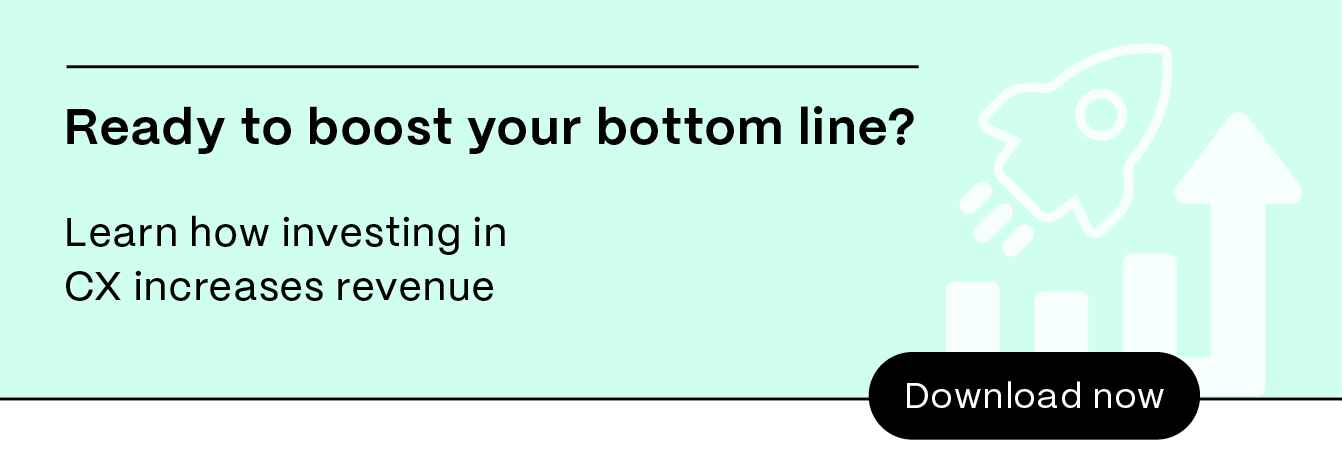
Blog
Measuring the ROI of customer experience: understanding its impact

Customer experience (CX) encompasses every interaction a consumer has with your company, from initial contact to post-purchase support. Businesses that prioritize seamless CX increase loyalty and revenue growth. Conversely, poor customer experience threatens$3.7 trillion of 2024 global sales.
Understanding CX's return on investment (ROI) is essential, as it impacts profit, performance, and long-term success. But measuring the ROI of something as intangible as an experience can be challenging. Clear metrics and ongoing analysis are key to evaluating its true effectiveness.
This article breaks down how to effectively measure CX ROI, explores its influence on business outcomes, and offers actionable tips to boost your CX strategy.

Key takeaways
- Customer experience ROI refers to the measurable return that businesses get from investing in improved consumer interactions and satisfaction.
- A few reasons why tracking CX ROI matters include better decision making, boosted retention, and increased revenue.
- CX influences sales by improving conversion rates and encouraging upselling.
- A well-executed CX strategy has a far-reaching impact on the company, from employee morale to operational efficiency.
- There are five steps to effectively measure CX ROI, such as collecting the right data that matches your identified goals and metrics.
- Personalizing interactions and investing in employee training are a few ways to boost the impact of your CX.
What is customer experience ROI?
Customer experience ROI refers to the measurable return that businesses get from investing in improved consumer interactions and satisfaction. Like any other form of ROI, it evaluates the financial benefit (or value) generated for every dollar spent on improving CX initiatives.
The goal is to understand how efforts in support, user interface design, personalization, and service quality translate into tangible business outcomes. These results include increased revenue as well as higher customer retention and lower acquisition costs.
Related read: Modernize your Client Experience with ShareFile® for Accounting
Why is measuring customer experience ROI important?
Organizations that clearly link customer happiness to measurable outcomes like growth, margin, and profitability are more likely to achieve CX success. This connection helps justify investments and secure29% more CX budgets.
Additional reasons why tracking CX ROI matters:
- Better decision making: Gathering insights allows you to focus on high-return strategies and avoid ineffective ones.
- Boosts retention: Retaining existing customers is often more cost effective than acquiring new ones. Positive CX reduces churn, enabling you to quantify cost savings from repeat customers.
- Increases revenue: Happy customers make frequent purchases and recommend your company to others. Measuring CX ROI shows how this amplified satisfaction drives sales and profits.
- Enhances brand loyalty and advocacy: Great CX creates brand advocates, which encourages word-of-mouth marketing and lowers acquisition costs through referrals.
- Drives competitive advantage: Measuring ROI helps assess how your experience compares to competitors and identifies areas for improvement.
- Supports long-term strategy: Consistently measuring CX ROI helps forecast future trends and behaviors, supporting strategic planning and keeping CX a top priority.
How does customer experience impact sales?
Positive interactions increase the likelihood of purchases, repeat business, and referrals. In fact, companies excelling in CX sawmore than double the revenue growth of "CX laggards" over a five year period.
Several ways CX influences sales:
- Improves conversion rates: Smooth, personalized experiences make interested buyers more likely to convert. Elements like easy navigation and readily available support build confidence and encourage purchases.
- Increases retention and repeat customers: Satisfied customers are more likely to stay loyal. Positive CX boosts long-term sales and reduces the need for costly acquisition efforts.
- Encourages upselling and cross-selling: Trust in a brand makes regulars more open to recommendations for purchasing additional or higher-value products.
- Fuels word-of-mouth and referrals: Happy customers become your best marketers by endorsing your brand to others, translating directly into new sales.
- Drives willingness to pay premium prices: Research shows54% of consumers are willing to pay more for excellent service, which can significantly raise revenue.
How does customer experience impact the company?
CX not only impacts sales, but overall company health and success. A well-executed CX strategy enhances everything from employee morale to operational efficiency, driving continued growth and sustainability.
CX impacts a company because it:
- Improves brand reputation: Companies with excellent CX are seen as trustworthy and reliable, bolstering brand image.
- Strengthens customer lifetime value (CLV): Customers who consistently have good experiences are more likely to remain engaged. This helps lower acquisition costs and generate more predictable revenue.
- Reduces operational costs: An effective CX strategy streamlines processes, reducing the need for manual intervention and enabling customers to resolve issues on their own more easily.
- Increases employee engagement: When employees see the positive impact of their work, it fosters a sense of purpose and raises engagement.
- Boosts innovation and adaptability: Feedback yields upgraded products, services, and processes. Companies that listen to their customers are more agile and better positioned to adapt to market changes.

CX ROI metrics
Measuring CX ROI involves tracking key criteria that reflect customer happiness, loyalty, and financial impact.
While your CX ROI metrics should align with business goals, some common options include:
- CLV: Represents the total revenue expected from a customer over the span of their relationship. Great CX leads to higher CLV as faithful buyers make repeat purchases.
- Customer churn rate: Measures the percentage of customers who stop doing business with your company over a given period. Low churn rates indicate strong retention, often driven by superior CX.
- Average transaction size: Tracks the average dollar amount spent per transaction. A better CX can lead to larger transactions, as happy customers are more likely to be upsold.
- Cost of support: Looks at how much a company spends resolving customer issues. Positive CX, including intuitive self-service options, reduces support costs by lowering the volume of service tickets.
- Net promoter score (NPS): Gauges loyalty by asking how likely customers are to recommend your company. A high NPS signals customer approval, driving referrals and reducing acquisition costs.
- Customer satisfaction score (CSAT): Assesses how satisfied customers are with a specific interaction or overall experience. A high CSAT indicates successful CX efforts, while a low score reveals areas for improvement.
How to measure the ROI of customer experience
With a structured approach, businesses can quantify the financial impact of CX initiatives to optimize efforts, justify investments, and align strategy with goals. This step-by-step process includes:
1. Defining your CX goals
Before you can measure the ROI of CX, you need to establish clear goals. Are you focused on bettering customer satisfaction, reducing churn, increasing repeat purchases, or lowering the cost of support? Your CX objectives will guide the metrics you track and help determine the overall impact to your business.
2. Identifying relevant CX metrics
Once you’ve established your goals, select the most relevant CX metrics to track progress. For example: if your goal is to increase customer retention, then focus on criteria like churn rate, retention rate, and CLV. Make sure to choose a combination of quantitative (e.g., average transaction size) and qualitative (e.g., NPS) metrics that align with your CX strategy.
3. Collecting and analyzing customer data
Once goals and metrics are chosen, be sure to gather your data from multiple touchpoints for accurate measurement. Use surveys, feedback forms, website analytics, and support records to collect real-time information on interactions. Data analytics tools can help track behavioral patterns, such as repeat purchases or average transaction size, giving you a complete picture of how CX initiatives are performing.
4. Calculating the financial impact of CX initiatives
To measure financial ROI with your data, quantify how CX upgrades translate into profit, cost savings, or long-term value. For example, track how a great service experience leads to reduced churn or increased CLV. Similarly, calculate cost savings from operational efficiency, such as a reduction in support costs due to higher FCR (first contact resolution) rates. Linking these improvements to financial metrics helps determine the exact dollar value generated by your CX investments.
5. Monitoring, reporting, and iterating
Regularly review CX metrics and financial data to assess the ROI of your efforts. If certain initiatives aren’t delivering the expected returns, adjust your strategy and reallocate resources. CX is an ongoing process, and consistent monitoring will help ensure that you’re always improving and optimizing for better results.
4 ways to boost the impact of your customer experience
Enhancing CX is not just about meeting expectations, it’s about exceeding them to create advocates for your brand. When businesses strengthen CX, it not only fosters loyalty but also increases the ROI associated with those experiences.
Here are four effective ways to boost the impact of your CX:
1. Personalize interactions
Use data to personalize interactions and recommendations to make customers feel valued and understood, leading to higher satisfaction and increased sales. For example, CRM (customer relationship management) systems can track consumer behaviors and preferences, enabling you to provide customized recommendations, marketing, and support.
2. Prioritize feedback
Actively analyze and act on customer feedback to understand pain points and preferences, enabling informed improvements. This can be done through surveys, reviews, and direct interactions. Implementing changes based on this insight demonstrates that you appreciate their opinions, which amplifies the overall experience.
3. Invest in employee training
Happy, well-trained employees are more likely to create great interactions with consumers, ultimately bettering CX. Invest in training programs that equip your team with the skills and knowledge to engage with customers effectively. You should also foster a culture of empowerment and recognition, where employees feel respected and motivated to provide outstanding service.
4. Streamline processes
Make the customer journey as smooth and efficient as possible. Make optimizations to reduce effort and frustration, enhancing satisfaction and encouraging repeat business. Identify and eliminate bottlenecks in your processes and improve them with automation software. For example, simplify navigation on your website and ensure customer service is easily accessible.
Conclusion
By quantifying the ROI of CX initiatives, you can create a win-win-win scenario: happier customers, more engaged employees, and increased profits.
However, it’s important to continually measure and refine your CX strategies to remain competitive and impactful. Setting clear goals, leveraging data, and seeking customer feedback enables you to adapt to evolving needs and build lasting relationships. As a result, you’ll transform customers into brand advocates who drive growth.
Related Resources

Blog